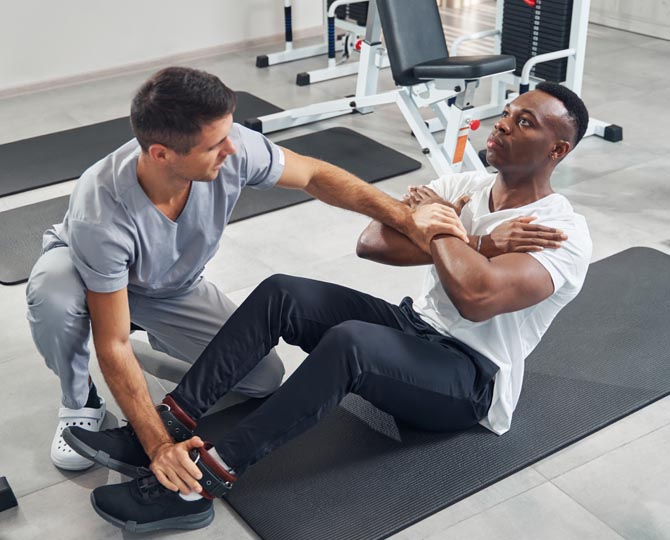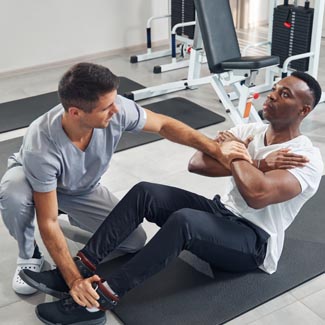When your clients are regularly engaging in physical activity—especially if it’s at a high intensity—they’ll almost inevitable get injured at some point. What often makes the biggest difference, though, is how an injury is managed and how an athlete’s rehab training plan is structured. It can determine whether they recover quickly or end up dealing with repeat injuries that drag out the healing process.
Rest phase:
The first step to recovering from an injury is to protect the affected area. This helps prevent further tissue damage while the body enters the initial inflammatory phase, a necessary part of healing (1). Pain may be unpleasant, but it’s there to protect the body and usually fades over time. However, it often subsides before the injured tissue has fully healed. That’s why it’s easy to fall into the trap of resuming training too soon if you use pain as your only indicator of recovery. This is where education becomes a key part of an athletic therapist’s role—helping clients understand the importance of this early rest phase. In most cases, it involves a period of inactivity, which can lead to some level of deconditioning. But the longer the inactivity, the more pronounced the deconditioning (2). And that can increase the risk of relapse or further injury, which can delay recovery. To support an effective return to activity, it’s essential to understand what kind of injury your client has. For instance, muscle strains tend to heal faster than ligament sprains or bone injuries like stress fractures (3). Once the injury has been identified, the goal is to limit deconditioning by putting the right strategies in place as early as possible (4).
Return to activity: Your client is ready to move—but carefully!
Cardiovascular activity, when well tolerated, can speed up the healing process by delivering more nutrients to the affected area. When an athlete has a limb injury, training the other limb can be surprisingly effective. Rather than causing lopsidedness, this helps slow muscle loss in the injured limb through a phenomenon known as cross education (5). It’s also important to assess the specific physical demands that will eventually be placed on the recovering joint or muscle. Is the goal to restore range of motion, build strength, improve endurance, or regain power? And how much? Making gradual, step-by-step progress toward those goals is often the key to a successful recovery. Of course, a generally healthy lifestyle also supports the healing process, especially getting at least seven hours of quality sleep every night and eating a varied, high-protein diet (6).
Kinesiologists are trained to guide effective progress toward a return to physical activity. By working closely with athletes—and in collaboration with other health professionals when needed—they monitor the gradual recovery of physical abilities and make sure the progress is aligned with each client’s specific goals. Client feedback should play a central role in this process. Athletes need to learn to listen to their bodies—signs like excessive fatigue or pain during certain movements may indicate it’s too soon to move on to the next phase of rehabilitation (7). This collaborative approach, along with patience, discipline, and a positive mindset, helps athletes return to their full potential. In many cases, the training hours accumulated during injury recovery can even leave the body more resilient than it was before (8).
Nicolas Blanchette practises osteopathy and kinesiology with Ostéo-Solution in Saint-Eustache, located on Montreal’s North Shore. You can book an appointment with him at www.osteo-solution.com
This article provides general information only and does not replace the recommendations or care of a health professional.
References :
- Coger V, Million N, Rehbock C, Sures B, Nachev M, Barcikowski S, Wistuba N, Strauß S, Vogt PM. Tissue Concentrations of Zinc, Iron, Copper, and Magnesium During the Phases of Full Thickness Wound Healing in a Rodent Model. Biol Trace Elem Res. 2019 Sep ;191(1) : 167-176.
- Appell HJ. Muscular atrophy following immobilisation. A review. Sports Med. 1990 Jul;10(1):42-58. doi: 10.2165/00007256-199010010-00005. PMID: 2197699.
- Jan YK, Major MJ, Pu F, Sonenblum SE. Editorial : Soft Tissue Biomechanics in Wound Healing and Prevention. Front Bioeng Biotechnol. 2022 Apr 5;10:897860. doi: 10.3389/fbioe.2022.897860. PMID: 35449596; PMCID: PMC9017806.
- Wall BT, Morton JP, van Loon LJ. Strategies to maintain skeletal muscle mass in the injured athlete: nutritional considerations and exercise mimetics. Eur J Sport Sci. 2015;15(1):53-62. doi: 10.1080/17461391.2014.936326. Epub 2014 Jul 16. PMID: 25027662.
- Andrushko JW, Lanovaz JL, Björkman KM, Kontulainen SA, Farthing JP. Unilateral strength training leads to muscle-specific sparing effects during opposite homologous limb immobilization. J Appl Physiol (1985). 2018 Apr 1;124(4):866-876. doi: 10.1152/japplphysiol.00971.2017. Epub 2017 Dec 14. PMID: 29357520; PMCID: PMC5972467.
- Jäger, R., Kerksick, C.M., Campbell, B.I. et al. International Society of Sports Nutrition Position Stand: protein and exercise. J Int Soc Sports Nutr 14, 20 (2017). https://doi.org/10.1186/s12970-017-0177-8
- Abernethy L, Bleakley C. Strategies to prevent injury in adolescent sport: a systematic review. Br J Sports Med. 2007 Oct ;41(10) : 627-38. doi: 10.1136/bjsm.2007.035691. Epub 2007 May 11. PMID: 17496070; PMCID: PMC2465167.
- Faigenbaum AD, Myer GD. Resistance training among young athletes: safety, efficacy and injury prevention effects. Br J Sports Med. 2010 Jan ;44(1) : 56-63. doi: 10.1136/bjsm.2009.068098. Epub 2009 Nov 27. PMID: 19945973; PMCID: PMC3483033.

